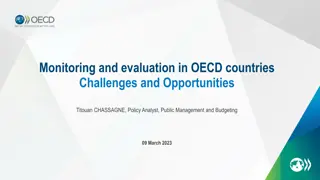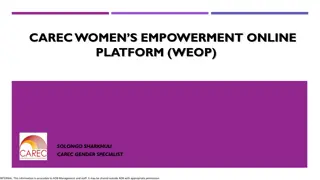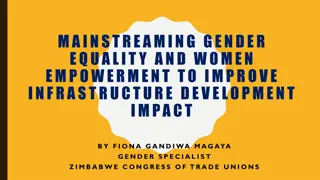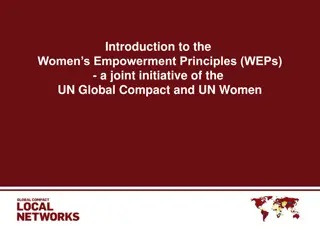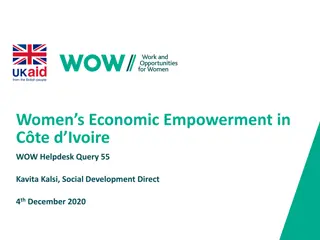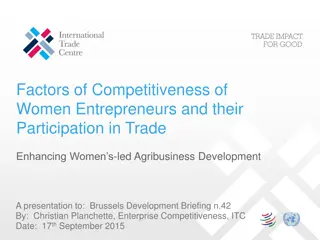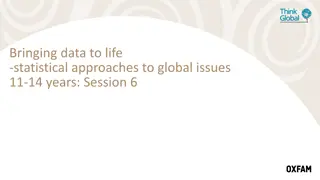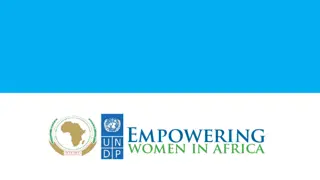Lessons from OECD Policy Dialogue on Women's Economic Empowerment
Measuring Unpaid Care Work to Inform Policy-Makers. OECD Policy Dialogue aims to unlock women's economic potential by recognizing, reducing, and redistributing unpaid care and domestic work through better policies. Generating cross-country comparable measures of unpaid care work is crucial for policy guidance.
Uploaded on Mar 13, 2025 | 2 Views
Download Presentation

Please find below an Image/Link to download the presentation.
The content on the website is provided AS IS for your information and personal use only. It may not be sold, licensed, or shared on other websites without obtaining consent from the author.If you encounter any issues during the download, it is possible that the publisher has removed the file from their server.
You are allowed to download the files provided on this website for personal or commercial use, subject to the condition that they are used lawfully. All files are the property of their respective owners.
The content on the website is provided AS IS for your information and personal use only. It may not be sold, licensed, or shared on other websites without obtaining consent from the author.
E N D
Presentation Transcript
Measuring Unpaid Care Work to Inform Policy-Makers on Women s Economic Empowerment: Lessons learnt from the OECD Policy Dialogue Ga lle Ferrant
OECD Policy Dialogue on Womens Economonic Empowerment and Unpaid Care Work: a special focus on SDG 5.4 Unlocking Women s Economic Potential by Recognising, Reducing and Redistributing Unpaid Care and Domestic Work through better policies addressing: Infrastructure Social protection Public services Shared responsibilities within the household and gender norms Generate cross-country comparable data Produce evidence-based analysis Provide policy guidance on what works to Recognise, Reduce and Redistribute unpaid care and domestic work
Generating cross-country comparable measure of unpaid care work Time Use Surveys (TUS) have been conducted in 83 countries (30 OECD countries + 53 non-OECD economies) A number of comparability issues affect TUS, e.g. different classifications, population coverage, simultaneity of activities, etc Selection criteria: Population coverage (e.g., national, urban, rural) Year of the survey (TUS are conducted every 5/10 years) Availability of micro data Coverage of different world regions and income levels (low- and middle-income countries) Bangladesh, Ethiopia, Peru, South Africa + 30 OECD Countries
Recognising UPCW as a female economic contribution Unpaid care work is not considered an economic activity : Unpaid goods and services produced by household members for their own consumption were excluded from GDP ineffective policymaking that does not account for the constraints individuals, particularly women, face when pursuing different economic and social activities incorrect inferences about an individuals well-being and the value of time Unpaid care work represents a significant share of countries GDP: USD 11 trillion, or 9% of global GDP (ILO, 2018) In the UK: extended GDP (home produced services + GDP) grew at an average annual rate of 3.8% per year between 2005 and 2014, compared to 3.5% using the standard GDP computation As women perform more than 75% of household productive activities, these calculations provide a more realistic estimate of women s contribution to the national economy, challenging the traditional view of men s greater economic productivity
Unpaid Care Work: the Missing Barrier to Women s Economic Empowerment Higher inequalities in UPCW, higher inequalities in labour market outcomes Note: Controlling for GDP per capita, fertility rate, urbanisation rate, maternity leave and gender inequality in unemploymentand education. Source: World Bank (n.d.), World Development Indicators and OECD (2018), Gender, Institutions and Development Database.
Gender Gap in UPCW and GDP access to time- saving technology and infrastructure Huge time women spend on UPCW GDP per capita Gender Gap in UPCW time but persistent Discriminatory social norms as measured by the SIGI Slight time men spend on UPCW GDP per capita
Informing Policy-Makers: focus on access to infrastructure Access to electricity: 34% of the Ghanaian women do not have access to electricity in their house Having electricity at one s house increases women s time in paid activities (formal or informal) by 73 minutes Access to water 19% of women are fetching water vs 6% of men for 25% of the Ghanaian Households drinking water is piped into their house, their garden, or their neighbour s yard
Conclusion UPCW: a missed opportunity policies very rarely incorporate addressing UCW as an objective (harmonised) TUS are restricted UPCW: a barrier to women s economic empowerment Higher gender time use gap, higher gender gaps in labour market outcomes Need for public commitment: GDP growth itself would not be enough to achieve equality on both UPCW and labour market outcomes Social transformation challenging traditional gender norms is needed to promote women s economic empowerment
Thank you for your attention Gaelle.Ferrant@oecd.org More information on http://www.oecd.org/development/womens-economic-empowerment.htm OECD Policy Dialogue on Women s Economonic Empowerment and Unpaid Care Work at www.genderindex.org Social Institutions and Gender Index (SIGI) http://www.oecd.org/gender/data/ OECD Time Use Database Ga lle Ferrant


